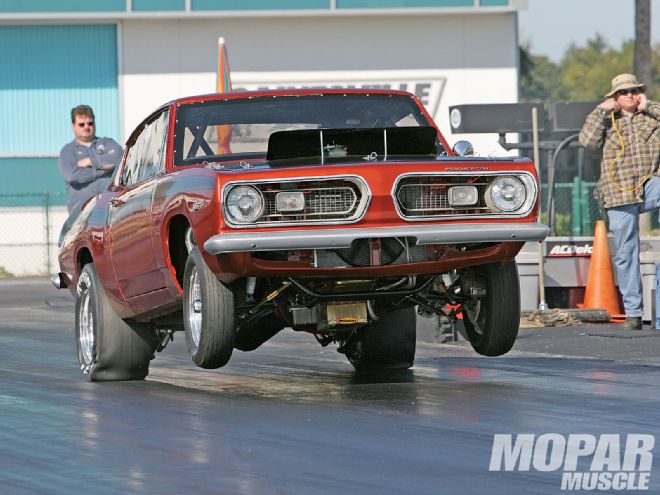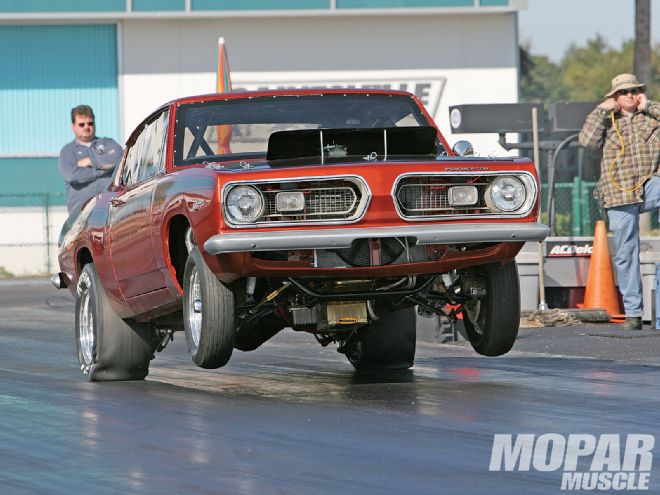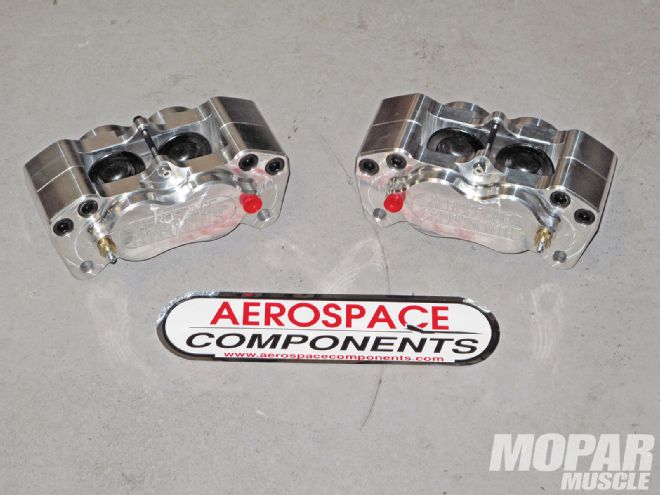
There are a lot of ways to make your street or strip car run quicker at the track, but the first ones most people think of nearly always have to do with making more engine power. And while a more powerful engine should get your car moving quicker and running faster in the quarter-mile, there are also other components that can greatly affect the acceleration rate. By lightening the transmission and its internal parts, the driveshaft, the differential, and even the axles, wheels, and brakes, it takes less power to turn these components, equaling more power left to propel your car in a straight line.
 Want to make your Mopar faster? We'll show you how we reduced our Plymouth Barracuda's weight....
Want to make your Mopar faster? We'll show you how we reduced our Plymouth Barracuda's weight....
And while maximum acceleration will ultimately be determined by a combination of factors, one way we've found to improve acceleration, enhance safety, and save weight in critical places is by converting your Mopar to aftermarket disc brakes. Remember that the brakes on our Mopars were mass-produced many years ago and are very heavy by today's performance car standards. Since our '67 Barracuda (Project B3) is pretty much a dedicated drag car, we didn't need the extra weight of factory vented rotors and cast iron calipers up front, so we decided to replace our car's heavy 11-inch drum brakes out back with aftermarket units as well.
Having had great luck with Aerospace Components products in the past, when we began looking for the brake parts we went directly to the Aerospace Components website to see what they had for our car. What we found was a great website with lots of information and multiple kits available for most Mopar body styles. The employees of Aerospace Components are gearheads and racers themselves, understanding the importance of quality and using the best lightweight materials in their brake systems.
Aerospace Components manufactures caliper brackets to mount to nearly any Mopar spindle, so converting from drum to disc or disc to disc isn't a problem up front. In the rear, Aerospace kits fit all the popular axles, including the 83/4 and Dana 60. To be sure you get the correct brakes for your car the first time, Aerospace Components asks that you fill out a worksheet, giving them information about the car's weight, use, lug pattern, and spindle dimensions. While this process takes a little time up front, it ensures that all of the components will fit properly when you get them, potentially saving time and headaches in the long run. Once we faxed in the worksheets for our car, the staff at Aerospace Components quickly assembled our kits and had them ready to pick up in a couple of days.
 ....and ran quicker elapsed times with these lightweight disc brakes from Aerospace Components.
....and ran quicker elapsed times with these lightweight disc brakes from Aerospace Components.
With our new brakes in hand and the car loaded in the trailer, we headed to Inline Performance Specialists in nearby Bushnell, Florida, to perform the installation on one of their lifts. This is an easy project for the average mechanic and can be accomplished with jackstands and a floor jack, but having a lift makes the work go a little quicker. Out of the box, we were initially impressed with the quality of the brake components. The four-piston calipers are machined from billet aluminum as are many of the other components. The rotors are drilled and slotted for maximum cooling, and brake pads and hardware are all included. We ordered flexible steel braided lines for all four corners as well, ensuring we had all the pieces we'd need for the installation.
Starting on a Saturday morning, we removed the stock brakes from our Barracuda and had the Aerospace Components brakes on the car and bled by four o'clock that afternoon working at a leisurely pace. Weighing the brakes showed us that the Aerospace disc brakes were a full 50 pounds lighter up front, and over 36 pounds lighter in the rear, for an impressive 86.56 pounds total weight savings. Even better, most of this is unsprung weight, where the benefits can be greater. Also, the lighter rotors will be easier to accelerate, and easier to stop, for better all-around performance and safety. Additionally, the aluminum calipers are designed with pistons that actually retract after the brakes are applied, greatly reducing parasitic drag caused by friction. All these advantages should add up to improved braking, and more importantly, better acceleration for our A-Body project car.
Back at Gainesville Raceway, our time slips certainly backed our expected performance gains, and the B3 ran an all-time best elapsed time. The Barracuda was launching harder, and transferring more weight to the rear wheels thanks to the lighter front brake assemblies, equating to better sixty foot times, better elapsed time, and higher speed in the eighth mile. At this level, tenths of a second are hard to come by, so for the price we feel that the Aerospace Component disc brake conversion is definitely money well spent. Read on and see how easy this installation was to perform, and find out how quick we ran at the track!